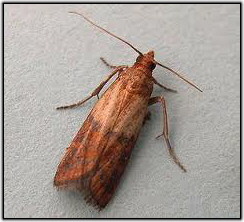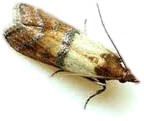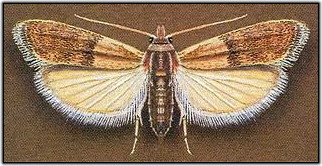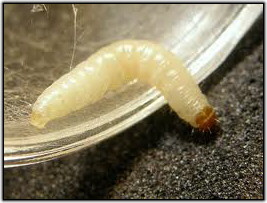Indian Meal Moth
 The Indian meal moth, Plodia interpunctella (Hubner), is one of the most commonly reported pests of stored grains in Canada.
The Indian meal moth, Plodia interpunctella (Hubner), is one of the most commonly reported pests of stored grains in Canada.
 Larvae of the Indian meal moth feed upon grains, grain products, dried fruits, nuts, cereals, and a variety of processed food products. The Indian meal moth is also a common pantry pest.
Larvae of the Indian meal moth feed upon grains, grain products, dried fruits, nuts, cereals, and a variety of processed food products. The Indian meal moth is also a common pantry pest.
The Indian meal moth is a handsome moth with a wing expanse of nearly three-quarters of an inch. It is easy to distinguish from other grain pests by the peculiar markings of the forewings; they are reddish brown with a copper luster on the outer two-thirds, but whitish gray on the inner or body ends. The hind wings lack distinctive markings and are more or less uniformly gray. Adults can be seen resting on the grain surface or grain bin walls. The adults fly at night and are attracted to lights.
The eggs of the Indian meal moth are whitish, ovate and very small. Because of their small size, they are difficult to see without the aid of a microscope. Eggs are deposited on the grain surface singularly or in groups of twelve to thirty.

Newly hatched larvae are very small and difficult to see. Larger larvae are usually yellowish, greenish, or pinkish. Fully grown larvae are a half to five-eighths of an inch in length with a brownish head capsule. Larvae have three sets of legs near the head (thoracic legs) and five sets of prolegs on the abdomen. Larvae of the meal moth spin a web as they become fully grown and leave behind silken threads wherever they crawl. The webbing is often sufficiently abundant to attract attention. Loosely clinging webbing on the grain is characteristic of this pest.
 Life Cycle
Life Cycle
As long as the temperature within a grain bin or building where grain is stored remains above 50° F, the Indian meal moth can survive and reproduce. A typical life cycle (egg to adult) is completed in forth to 55 days. A potential for seven to nine generations per year exists; however, because of cool temperatures during the winter months fewer generations are usually completed. Under optimal conditions, the entire life cycle can be completed in approximately 28 days.
A mature female lays 100 to 300 eggs on food material, either singularly or in groups of twelve to thirty. Larvae begin to hatch in two to fourteen days, depending on environmental conditions. Newly hatched larvae feed on fine materials within the grain and are small enough to pass through a 60-mesh screen. For this reason, it is difficult to exclude larvae from most packaged foods and grain.

